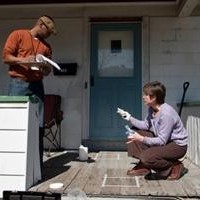January 28, 2015
Steven Turner of Action for a Better Community and Katrina Korfmacher with the University of Rochester take samples from porches of homes in the Maplewood neighborhood of Rochester.
A new study in the journal Environmental Research indicates that porches in older homes can be a significant source of lead dust and that housing regulations – which have been instrumental in lower rates of lead poisoning in recent years – need to be adapted to meet this threat to children’s health.
“This study shows that porches are an important potential source of lead exposure for children,” said Katrina Korfmacher, Ph.D. director of the Community Outreach and Engagement Core of the University of Rochester Medical Center Environmental Health Sciences Center and a co-author of the study. “It is becoming clear that porch dust lead can be effectively reduced through repairs, cleaning, and maintenance.”
Lead is a neurotoxin and has significant health, learning, and behavioral effects, even at levels previously thought to be safe. While federal, state, and municipal laws have contributed to a significant decline in the overall levels of childhood lead poisoning, rates remain high in some communities, particularly low income urban areas with older rental housing. An estimated 19 percent of homes in the U.S. contain lead paint hazards; this number rises to 35 percent in the homes of individuals below the poverty line. In Rochester, where the study was conducted, more than 86 percent of the housing stock was constructed prior to the ban on lead paint in 1978.
Some local communities, including Rochester, have adopted ordinances that require owners and landlords to take steps to ensure that the interiors of rental properties are “lead safe.” However, in many instances these requirements stop at the front door and do not cover exterior spaces and structures such as porches. No communities have standards limiting the amount of lead in dust on porches, because there is no federal standard and there has been limited evidence that mitigating lead hazards in these instances is feasible.
Porches hold the potential to be a source of lead hazards for young children, either from lead dust being tracked or blown into the house or through direct exposure. This is especially true in urban neighborhoods where porches often serve as the “front yard” where children play.
The new study was a partnership between the National Center for Healthy Housing (NCHH), the University of Rochester Medical Center, the City of Rochester, and Action for a Better Community, a Rochester-based non-profit organization.
The researchers sampled lead paint levels on porches at 79 homes in Rochester that had recently undergone lead abatement. Before work began, the researchers found that porch floor dust lead levels were nearly four times greater than dust lead levels on interior floors. When dust lead levels were higher on the porches, lead dust levels were also higher on the interiors of homes. After the porches were replaced or repainted, the porch dust lead levels significantly declined, indicating that the hazard can be effectively addressed by property owners.
The study also found that when interiors were treated for lead paint but no work was done on the exterior, the porch dust lead levels rose immediately after work, most likely from workers tracking dust and debris onto the porches. These findings appear to indicate that steps taken to make the interior of homes more “lead safe” may inadvertently be causing the porches to become more hazardous.
“Without a porch standard, no one was held accountable for cleaning porches after interior renovations,” said lead author Jonathan Wilson, Acting Director of NCHH. “Lead on porches should be addressed and standards for porch lead dust must be adopted to protect children from inadequate clean-up.”
Additional co-authors include Sherry Dixon, David Jacobs, Judith Akoto, and Jill Breysse with NCHH. The study was supported with funding from the U.S. Department of Housing and Urban Development.


